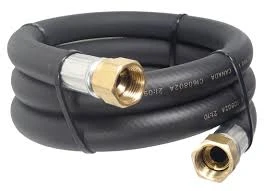335345435
Oct . 10, 2024 07:02 Back to list
Types of Hydraulic Hose Couplings and Their Applications in Fluid Systems
Understanding Hydraulic Hose Coupling Types
Hydraulic hose couplings are essential components in hydraulic systems, facilitating the connection between hoses and various equipment. Given the critical roles they play, understanding the different types of hydraulic hose couplings is paramount for anyone working within this domain, whether in maintenance, engineering, or manufacturing.
There are several common types of hydraulic hose couplings, each designed to meet specific operational requirements. Threaded couplings, for instance, feature a threaded connection that allows for a secure and leak-proof interface. These couplings can withstand high pressures, making them suitable for heavy machinery in construction and industrial applications.
Another prevalent type is the quick disconnect coupling. This design enables users to quickly connect and disconnect hoses, which is particularly advantageous in applications where frequent changes are necessary. Quick disconnects promote efficiency and reduce downtime, ensuring that machinery can be operated with minimal interruption.
Camlock fittings are also widely used, especially in applications involving the transfer of liquids. Their design features a cam-and groove mechanism that locks the coupling in place, providing a reliable seal. Camlock fittings are ideal for high-flow applications and are commonly found in agriculture and oil and gas industries.
hydraulic hose coupling types

Furthermore, flanged couplings are primarily used in high-pressure systems. They consist of a flat flange that is bolted to the equipment or piping, creating a strong, stable connection. Flanged couplings are beneficial in environments with substantial vibration or dynamic forces, as they maintain integrity under challenging conditions.
Lastly, the barbed coupling is a simpler design that uses a barbed end to grip the inside of the hose. This type of coupling is frequently utilized in lighter-duty applications and is easy to assemble, making it a popular choice for general plumbing and low-pressure tasks.
In choosing the appropriate hydraulic hose coupling, several factors must be considered, including the pressure requirements, fluid type, and environmental conditions
. Additionally, proper installation and maintenance of these couplings are vital to ensuring system reliability and performance.Overall, understanding the various types of hydraulic hose couplings is crucial for optimizing fluid power systems. By selecting the correct coupling type and ensuring proper usage, individuals can enhance the efficiency and longevity of hydraulic machinery, ultimately leading to improved operational performance.
-
SAE 100 R17 Black Smooth Cover Hydraulic Hose
NewsMar.07,2025
-
SAE 100 R17 Black Smooth Cover Hydraulic Hose
NewsMar.07,2025
-
SAE 100 R17 Black Smooth Cover Hydraulic Hose
NewsMar.07,2025
-
SAE 100 R17 Black Smooth Cover Hydraulic Hose
NewsMar.07,2025
-
SAE 100 R17 Black Smooth Cover Hydraulic Hose
NewsMar.07,2025
-
steel wire braided hydraulic hose
NewsMar.07,2025



